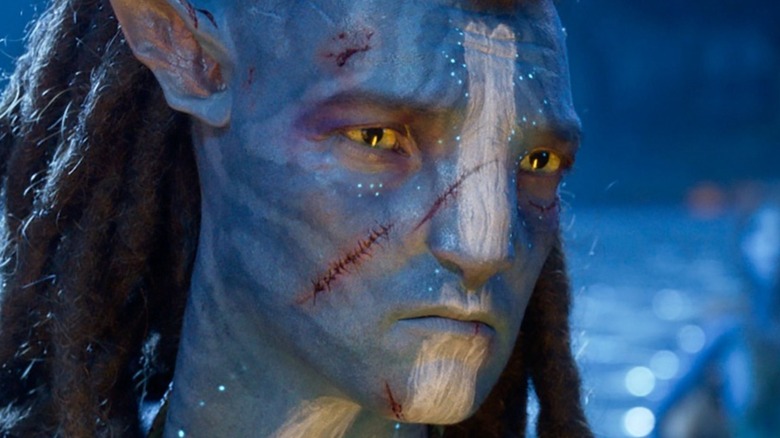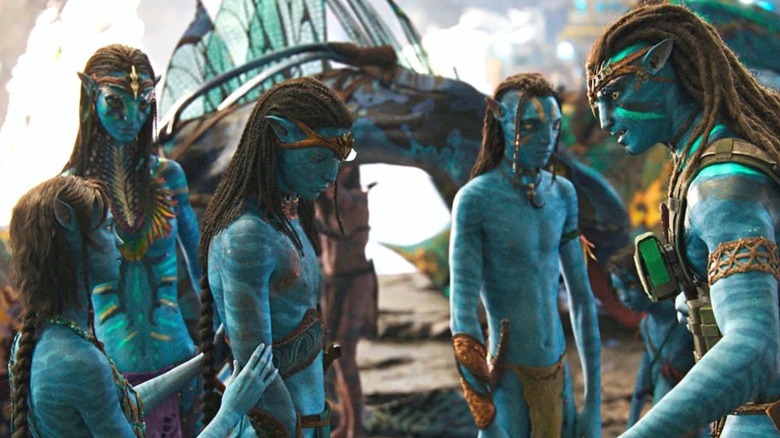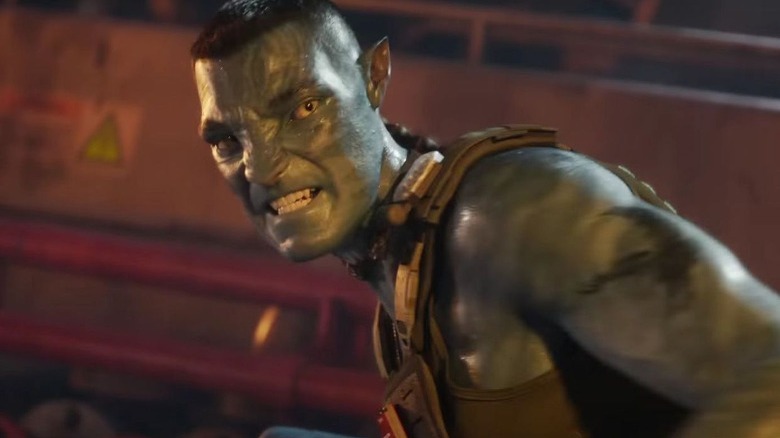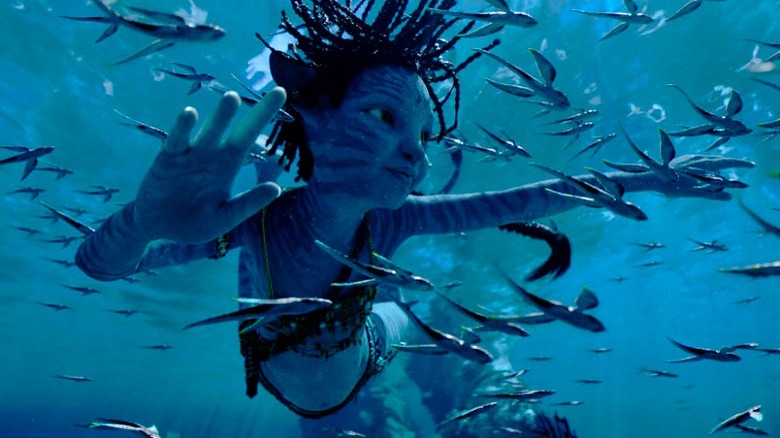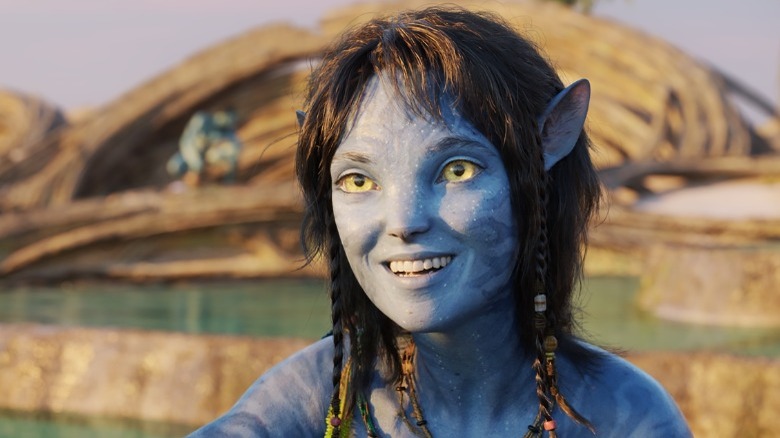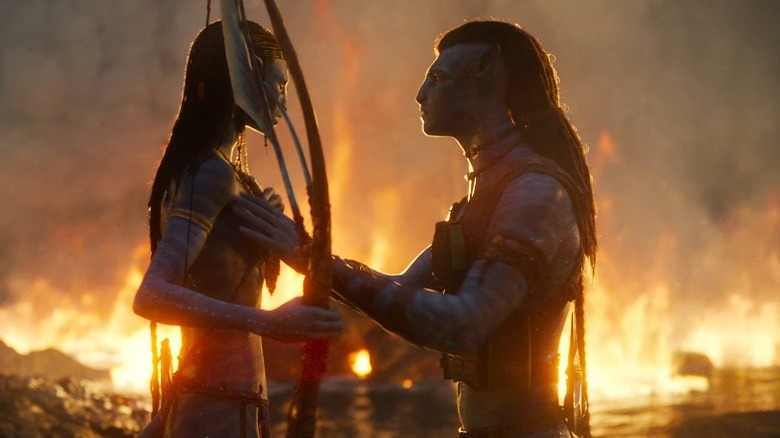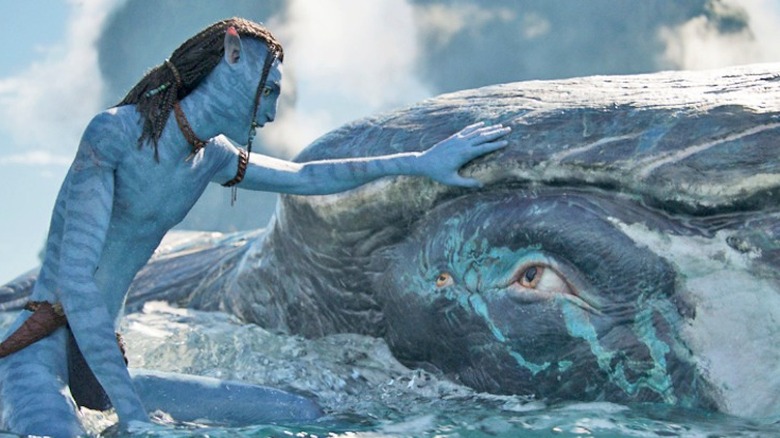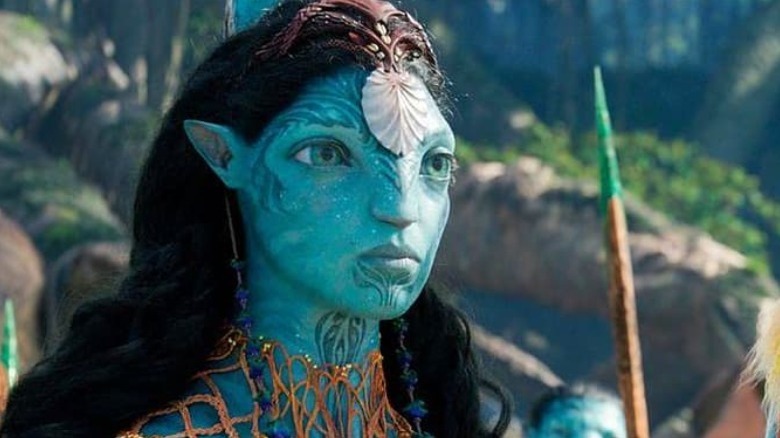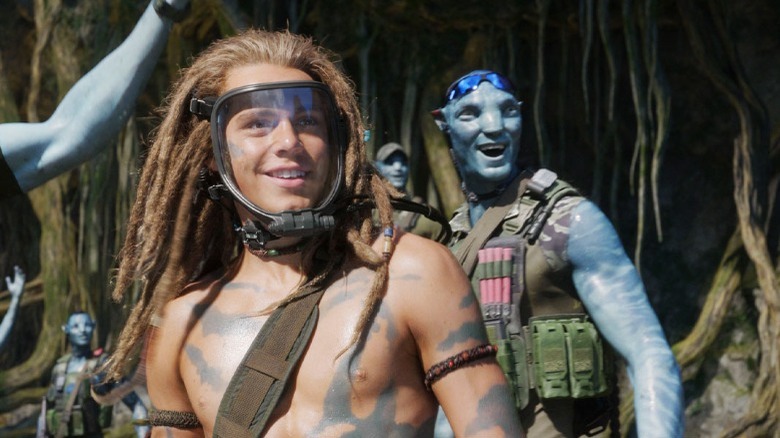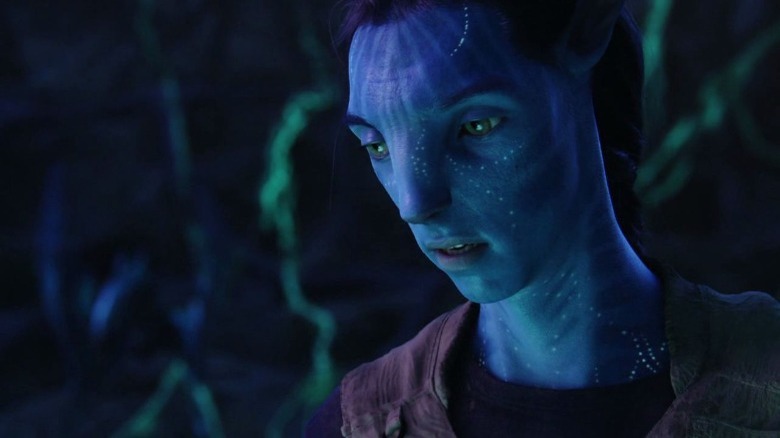Dumb Things In Avatar: The Way Of Water Everyone Ignored
James Cameron's "Avatar" is a cultural Rorschach test of sorts. It's the highest-grossing movie of all-time (retaking the title from "Avengers: Endgame" after a rerelease this year) but not the kind of iconic cultural tentpole that other epic movies have been. Since its release in 2009, it's been remembered more as a cinematic spectacle than a story, the pinnacle of the 3D blockbuster craze that's trailed off recently. "Avatar" created an entire culture in the Na'vi and transported us to an immersive entire world, but it required living with a certain amount of dumbness.
It's not just that "Avatar" is a thinly-veiled allegory for the colonization of North America by European settlers; it's that it's a spectacularly earnest and sincere attempt to capture something akin to Native American spirituality that was only possible at the tail end of the 2000s. With representation in media growing (with shows like "Reservation Dogs," "Rutherford Falls," and "Dark Winds"), it's all but impossible to imagine such a broad rehash of "Dances With Wolves" being pitched successfully today. So, as "Avatar: The Way of Water" has at long last arrived to turn the movie's success into a franchise (which will number five movies before its over, in theory), even to just jump back into Pandora requires living with a certain amount of cultural dissonance to get past the silliness of the basic premise.
The first "Avatar" was a tonal mix of naturalistic wonder and innocence that still explained us to laugh at winking humor like calling a precious mineral "Unobtanium." "The Way of Water" is both an expansive new story that doubles down on many elements of its predecessor and asks us to roll with several absurd new twists. Here are the dumb things in "Avatar: The Way of Water" that everyone ignored, in order to be transported to another planet once again.
It just replaces Na'Vi language with English
Most people don't go to the movies to read, so subtitles can often be a deal breaker when you're browsing the Netflix menu. If you have to read subtitles, you can't also laconically be on your phone while bingeing, after all. As Jake Sully (Sam Worthington) learned the ways of the Omaticaya Clan of the Na'vi in the first "Avatar," the movie was committed to showing both English and Na'vi being spoken consistently, and subtitling the alien dialogue (in Papyrus font, no less) whenever necessary. The way language was treated was logical and consistent.
But in "The Way of Water," director James Cameron and company must have realized early on that since Jake now has been living with the Na'vi for more than a decade, they would essentially be making a foreign language film. To solve this, very early in the sequel, Jakes tells us via voice-over that he's learned the Na'vi language so thoroughly that when he hears it, it "may as well be English," and presto: Suddenly we also hear his children and all other Na'vi speaking English. When Na'vi interact with other English-speaking characters later, they're still subtitled, but whenever Na'vi are talking to each other, it's all English for convenience's sake. It does save the audience a lot of Papyrus-reading, but it's a bracingly dumb and inelegant tweak to the rules of the way the reality of what we're seeing it being depicted.
After the earnest pride that the first "Avatar" took in realizing Na'vi culture, it's kind of shocking that "The Way of Water" just shrugs and transforms 90% of potentially Na'vi dialogue into plain old English.
Death apparently doesn't matter anymore
"Avatar: The Way of Water" is stuck in a strange limbo: It's both a sequel, picking up where "Avatar" left off in a literal sense, but also clearly made with a nostalgic zeal to remind people of the original. Think of the way the "Jurassic World" movies feel more like "Jurassic Park" theme park rides than actual extensions of a coherent story. The dumbest thing in "The Way of Water" that we just have to live with is how it shoe-horns new roles for Sigourney Weaver and Stephen Lang into the story, even though both of their characters died in the first movie.
Weaver's new character Kiri, a child mysteriously born of the Avatar of her original character Dr. Grace Augustine, at least has some strange messianic qualities that are unique, but asking us to just roll with Lang's psychotic Colonel Quaritch being reborn as a "Recombinant" form of Avatar is a bit much. It retcons "Avatar" in the sense that the technology to create a digital copy of a human consciousness apparently existed at the time, and Quaritch and his team backed themselves up before the final showdown. So essentially, like the ill-fated ending of "Lost," "The Way of Water" is asking us to invest in a world where death has no meaning. Were Grace Augustine and the other scientists also backed up? That would certainly explain why her Avatar is just hanging around inert in a tank, for no discernible purpose.
The whole plot is just: Save the children!
One of the dumbest things about "Avatar: The Way of Water" is that not much actually happens. Humans return to Pandora and begin to thoroughly colonize it, although it all happens off-screen in the blink of a "one year later" title card. From there, the movie is entirely composed of Jake and Neytiri (Zoe Saldaña) either hiding out or running away to keep their children safe, and the entirety of the action sequences are the result of their kids being in peril. The constant "save the children!" panic undercuts the movie's attempt to flesh the children out as individual characters: The Sullys are clearly being set up to be the Stark family of the "Avatar" franchise.
Multiple times Jake's kids have to radio him that they're in trouble, and he and Neytiri and various other tribal elders race to the rescue. At one point, the youngest Sully, Tuk (Trinity Jo-Li Bliss), bemoans out loud, "I can't believe I'm tied up again" as she's been recaptured by Quaritch mere minutes after being freed during the climatic struggle on the boat at the end.
I'll see your white savior and raise you an immaculate conception
The biggest criticism of the first "Avatar" is that Jake Sully is a classic white savior: It's tone deaf that way that a complete stranger to the Na'vi way of life ends up uniting the tribes and being chosen as Turok Makto. You'd think years later in "The Way of Water," since Jake has integrated more fully and had half-Na'vi children with Neytiri, that this would be less of a prevalent theme, but Kiri has been added to the story as a second white savior for the price of one. Though raised as a Na'vi, she's essentially a sort of reincarnated version of Grace Augustine, the other most benevolent white person from the first movie, and Kiri clearly has some "chosen one" type powers brewing as she communes with nature and can hear the heartbeat of Eywa, the all mother.
Not content to stop there, "The Way of Water" goes the same route as "Star Wars: The Phantom Menace" in introducing the idea of immaculate conception with a couple of casual off-hand remarks. It's apparently "a total mystery" how Grace Augustine's comatose Avatar gave birth to a child, although the movie pulls at a very disturbing thread a couple of times as Kiri and other characters wonder who her father might be.
Jake and Neytiri spend the whole movie running away
It really seems like we established it as a given in the first "Avatar" that "the Sky People will never stop coming." Ever since the destruction of Home Tree, more than a decade before the events of "The Way of Water," it's been clear that humans (or, at least, the mercenaries that they've sent to Pandora) hold nothing of Na'vi culture sacred and see them merely as impediments to colonization and harvesting resources. Nevertheless, when Quaritch starts targeting their family specifically, Jake and Neytiri make the decision to go on the run.
While it does lead to our fascinating introduction to the water-based Metkayina clan, it inevitably doesn't work as Quaritch pursues the Sullys to the islands before too long. Jake's entire function in the first "Avatar" was really just to convince the Na'vi tribes to stand and fight, so it's a bit surprising that becoming a family man has made him so much more cautious. Obviously, the "Avatar" franchise has three more sequels to set up, and "The Way of Water" was inevitably going to have to do a lot of table setting for the future of the story, but it could have done so in many ways without making our favorite warrior couple into scaredy-cats for the better part of three hours.
A new, even more precious most precious substance
Few sins of the original "Avatar" as unforgiveable as "unobtanium," the precious mineral that humans were on Pandora to harvest. Fortunately, no one utters that ridiculous word in "The Way of Water," and although the reappearance of humanity is abruptly handled, we do learn early on that they have a much more straightforward and urgent reason to return to Pandora than getting rich: Earth is dying, and Pandora is to be entirely colonized as humanity's new home. This creates a compelling global threat to all of the Na'vi clans that's not even based on a bad pun.
But fully two thirds of the way through "The Way of Water," we learn there's an entirely brand new magical substance that humanity is after on Pandora: a serum harvested from the brains of giant sentient whale-like creatures called Tulkuns. This enzyme, called Amrite, apparently stops the aging process entirely in humans. So the hunting of Tulkuns becomes another lazy, obvious allegory for the awful colonizers not to respect sacred Na'vi traditions: The Metkayina bond with the Tulkun and are heartbroken at their loss. The humans, of course, harvest just about a two liter soda bottle's worth of Amrite from a Tulkun the size of a battleship and leave the rest to rot.
A complete waste of Kate Winslet
Were you even aware that the great Kate Winslet is in this movie? She provides the voice of Ronal, the wife of the Metkayina's leader, and mostly glares disapprovingly at Jake and family for endangering her tribe. "The Way of Water" introduces many new characters, but not a single one has the star power of Winslet, an Oscar winner and one of the greatest actresses of her generation. So it's a bit dumb when you realize that like the majority of characters in this overstuffed movie, she didn't have time for any sort of character arc or sub-plot of her own.
While it's likely she has a bigger role to play in future installments, it doesn't make her bit part in "The Way of Water" any less of a missed opportunity. Other than mourning her "soul sister" Tulkun's death and being very justifiably angry at the Sullys for bringing destruction with them out to the islands, Ronal barely registers. This is why Kate Winslet had to hold her breath underwater for more than seven minutes?
Spider, I am (not) your father
Probably the most preposterous running thread in "Avatar: The Way of Water" is the relationship between the Recombinant Colonel Quaritch and his long lost son, Spider (Jack Champion). Spider is the most prominent fully human character left in the story, having been left on Pandora as a small child and raised with the Na'vi. Like many of the father/son relationships in "Star Wars" and other epic sagas, "The Way of Water" wants us to buy into big plot points pivoting on the burgeoning emotional bond between this child of two worlds and the lab-grown Avatar of his deceased father.
The problem with this is that Quaritch, in either human or Avatar form, is by far the most one-dimensional character in either movie. He's nothing but a murderous soldier, and he outright tells Spider that since he's technically a clone (sort of), he's not actually his father anyway. After holding Spider hostage for most of the movie, Quaritch suddenly is concerned about him when Neytiri threatens his life in a late standoff, a scene that comes essentially out of nowhere. Spider then saves Quaritch's life, which doesn't feel earned at all, and doesn't even really matter because presumably the humans could just keep growing new Quaritch Recombinants and re-downloading his consciousness anyway.
Apparently Na'vi can't drown?
It's never clear in "Avatar: The Way of Water" how worried to be that anyone can breathe. In addition to the somewhat confusing rules on how long Na'vi/Avatars/Recombinants can breathe in a fully oxygenated atmosphere, "The Way of Water" mines a lot of drama from its characters nearly drowning underwater, only to reveal time and time again that it's all but impossible for at least Na'vi people to run out of oxygen.
At first, Lo'ak is clearly scene to pass out underwater without reaching the surface in time, and the screen fades to black. But he's rescued and lifted out by his new Tulkun friend, presumably just in the nick of time. But the big showdown between Jake and Quaritch at the end takes this several steps further and has both of them clearly lapse into unconsciousness, spend several minutes underwater, and then easily be revived as soon as they break the surface of the water. Peril is useless if we don't have a clear understanding of how mortal it happens to be: "The Way of Water" could have thrown us a line or two establishing the limits.
Frontal-lobe epilepsy?
One of the strangest scenes in "Avatar: The Way of Water" is when Norm (Joel David Moore) and Max (Dileep Rao) fly out to the islands to try and see what's going on with Kiri, who had a seizure while connected to the Metkayina version of the Spirit Tree. Attaching diodes and machines to Kiri's head, Norm speculates that her spiritual connection to Eywa may be a side effect of epilepsy, an abrupt and strange suggestion after lots of evidence that there may be nothing special about Kiri at all.
This flies in the face of the generally faith-forward nature of both "Avatar" movies and never gets followed up on. In general, the spiritual purity of the Na'vi and the real-world influence of Eywa is empirically obvious: In the first movie, the Na'vi basically are losing the fight until Eywa intervenes and possesses all the animal life on the planet to attack the human forces. "Avatar" as a franchise has no interest in sincerely exploring the delicate balance between science and faith, not in the way a move like "Contact" approaches it, for example. This scene, which dabbles in skepticism just for the sake of a distraction, is one of the dumbest in "The Way of Water."
